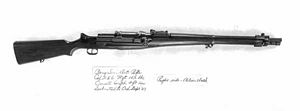| This article may be confusing or unclear to readers. Please help clarify the article. There might be a discussion about this on the talk page. (September 2013) (Learn how and when to remove this message) |
| M1922 rifle | |
|---|---|
 The Model 1922 Bang rifle using the sliding muzzle-cap system. The Model 1922 Bang rifle using the sliding muzzle-cap system. | |
| Type | Semi-automatic rifle |
| Place of origin | United States |
| Production history | |
| Designer | Søren Hansen Bang |
| Specifications | |
| Cartridge | .30-06 Springfield, 6.5×55mm Swedish |
| Action | gas-operated, rotating bolt |
| Sights | iron sights |
The Model 1922 Bang rifle is a US semi-automatic rifle designed by the Danish arms designer Søren Hansen Bang. It was a modification of the earlier Models of 1909 and Model 1911 Bang rifles, both chambered in the .30-06 Springfield round.
Overview

It was gas operated, using a sliding muzzle cup system which was blown forward by the combustion gases while the bullet emerged from the barrel. This ".256 Bang" rifle was a top candidate from 1925 to 1928 for US contracts ultimately won by the M1 Garand. Bang himself demonstrated his own models in US field trials in 1919 and 1927. The Bang rifle was ultimately unsuccessful in US government testing because of its mechanical complexity and susceptibility to gas fouling of the sliding muzzle cup.
The Bang blow-forward gas system, originally developed in 1903, inspired several other weapon developments: it was used in the unsuccessful French Puteaux APX machine gun of 1904, in its direct successor the controversial St. Étienne Mle 1907 machine-gun, and in the Gewehr 41, where it suffered the same shortcomings.
Patents
- U.S. patent 901,143, October 13, 1908, Device for Automatic Firing of Self-Loading Arms, Inventor Søren H. Bang of Copenhagen, Denmark
- U.S. patent 1,534,486, April 21, 1925, Self-Loading Firearm, Inventor Søren H. Bang of Copenhagen, Denmark
References
- "Experimental semi-automatic rifles, 1919-1931- excluding Garand's and Pedersen's rifles - Springfield Armory National Historic Site (U.S. National Park Service)". www.nps.gov. Retrieved January 9, 2011.
External links
- material #2 from Forgotten Weapons
- Hatcher's Notebook by Julian S. Hatcher, 1952, The Stackpole Company.